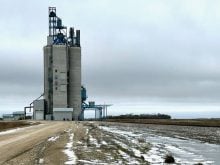SWIFT CURRENT, Sask. – Two years out of every decade, Pat Hays doesn’t have water to irrigate his hay land at Eastend, Sask.
He is concerned the International Joint Commission that is now considering a reopening of the 1921 apportionment agreements on the St. Mary’s and Milk rivers in Montana and Alberta could affect water for his cattle.
“This is a big issue. We don’t have any water to give away,” said Hays of the Lower Frenchman Water Users Association. He and other area farmers have invested “big dollars” in irrigation.
Read Also

Internet of Things tapped for better emissions insights
Interconnected field sensor fleet allows better soil monitoring coverage and, hopefully, live insights on farm greenhouse gas emissions and nitrogen fertilizer application for farms.
Hays expressed alarm that Saskatchewan Agriculture was absent from a recent commission meeting on the subject in Eastend, one of four meetings held in Canada and the United States.
The St. Mary’s River flows into Alberta and the South Saskatchewan River system, while the Milk River flows from Montana to Alberta and back to Montana.
More than 40 percent of the U.S. entitlement comes from the eastern tributaries, which include Battle and Lodge creeks and Frenchman River. They flow from Saskatchewan into the Milk River in Montana.
Any changes could affect tributaries and interprovincial water sharing agreements, the Saskatchewan Irrigation Projects Association annual conference was told Dec. 6-7.
“It’s going to touch every one of us whether we irrigate or not,” said SIPA director Ron Tittle, who represents the Southwestern District Association.
SIPA made a submission supporting the status quo position taken by the Alberta Irrigation Projects Association to the international commission. Both bodies say infrastructure such as water storage facilities in Saskatchewan and Alberta have been developed to operate within the guidelines of the current agreement. Neither Alberta nor Canada wishes to reopen the agreement.
Wayne Dybvig, vice-president of operations for the Saskatchewan Watershed Authority, said 33,000 irrigated acres in Saskatchewan operate off the eastern tributaries.
For area beef cattle, there are water shortages up to 45 percent of the time. Without storage, their needs would be met only 15 percent of the time, he said.
Dybvig said there is an effective working relationship in place among managers and users of the agreement and saw no reason to reassess the agreement.
He noted Montana, through a surplus of flows, already gets more than its 50 percent allotment.
“Stable agreements are critical to long-term planning,” Dybvig said.
AIPA executive director David Hill put it more bluntly.
“If it ain’t broke, don’t fix it,” he said.
Hill cited the millions of dollars invested in irrigation infrastructure and returned to farmers and communities from increased value crops, processing, recreation and tourism and enhanced wildlife habitat.
“Adding a new uncertainty into the mix is not a welcome venture,” said Hill.
“The strength of moving forward is based on certainty, not uncertainty,” he said in an interview.
The Alberta association appeared at all four commission consultations and focused its presentations on showing how well Alberta has used and developed the water and its plans for the future.
In a presentation to SIPA delegates, Hill noted Alberta’s long-term water strategy includes ensuring a safe, secure drinking water supply, healthy aquatic ecosystems and reliable adequate water sources for a sustainable economy.
“Government can be a catalyst but it’s those of us on the ground who do the work. It’s really our job to move this along,” said Hill.














